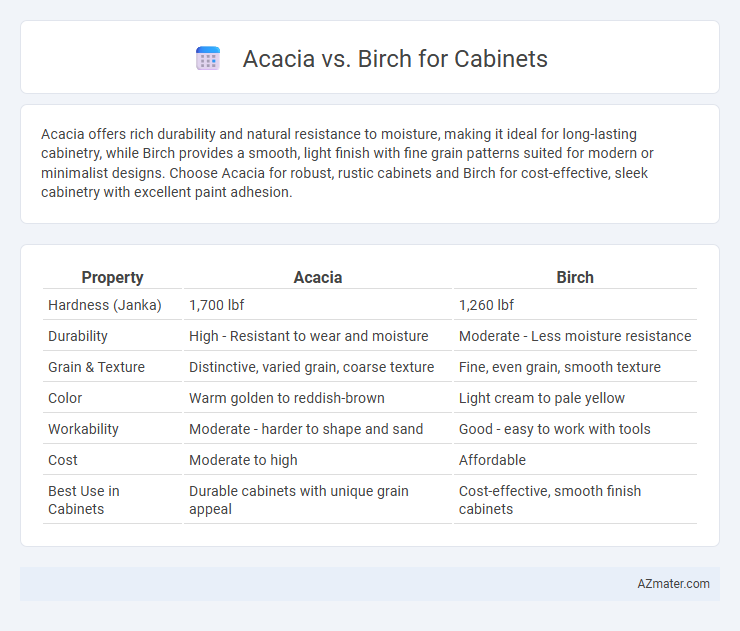Acacia offers rich durability and natural resistance to moisture, making it ideal for long-lasting cabinetry, while Birch provides a smooth, light finish with fine grain patterns suited for modern or minimalist designs. Choose Acacia for robust, rustic cabinets and Birch for cost-effective, sleek cabinetry with excellent paint adhesion.
Table of Comparison
| Property | Acacia | Birch |
|---|---|---|
| Hardness (Janka) | 1,700 lbf | 1,260 lbf |
| Durability | High - Resistant to wear and moisture | Moderate - Less moisture resistance |
| Grain & Texture | Distinctive, varied grain, coarse texture | Fine, even grain, smooth texture |
| Color | Warm golden to reddish-brown | Light cream to pale yellow |
| Workability | Moderate - harder to shape and sand | Good - easy to work with tools |
| Cost | Moderate to high | Affordable |
| Best Use in Cabinets | Durable cabinets with unique grain appeal | Cost-effective, smooth finish cabinets |
Introduction: Acacia vs Birch for Cabinets
Acacia and birch are two popular wood choices for cabinets, each offering distinct characteristics in durability, appearance, and cost. Acacia wood is known for its rich color variations, natural resistance to moisture, and exceptional hardness, making it ideal for high-traffic kitchen environments. Birch wood features a smooth grain and lighter color tone, providing a clean, uniform look with moderate durability and affordability for budget-conscious cabinet projects.
Wood Grain and Appearance Comparison
Acacia wood features a rich, varied grain pattern with swirling, irregular streaks that create a striking, natural look, often showcasing dark brown and golden hues. Birch has a more uniform, straight grain with a fine, smooth texture and lighter tones ranging from pale cream to light reddish-brown, offering a subtle and clean appearance. The contrast between Acacia's dramatic, rustic aesthetic and Birch's consistent, refined look makes Acacia ideal for bold, statement cabinetry, while Birch suits modern, minimalist designs.
Durability and Hardness
Acacia wood exhibits superior durability and hardness compared to birch, making it highly resistant to dents, scratches, and wear in cabinet applications. With a Janka hardness rating of around 1,700, acacia is significantly harder than birch, which ranges between 1,200 and 1,300. This makes acacia an excellent choice for cabinets subjected to heavy use or in high-traffic areas.
Cost Differences
Acacia wood cabinets typically cost more than birch due to their dense grain and natural durability, which offer enhanced resistance to dents and scratches. Birch is a more affordable option, favored for its smooth finish and light color that complements various design styles, but it may require additional treatments to improve longevity. The price gap between acacia and birch can impact budgeting decisions, especially for large-scale cabinet installations where material cost is a significant factor.
Workability and Installation
Acacia wood offers excellent workability due to its natural hardness and fine grain, allowing for precise cutting, sanding, and finishing in cabinet fabrication. Birch is also highly workable, known for its smooth surface and ease of shaping, reducing installation time with fewer adjustments needed on-site. Both woods provide strong structural integrity, but Acacia's density can demand sharper tools, while Birch's uniform texture simplifies joinery and installation processes.
Maintenance and Longevity
Acacia wood cabinets offer high durability and natural resistance to moisture and insects, requiring minimal maintenance such as regular dusting and occasional polishing. Birch cabinets are also sturdy but tend to be more susceptible to water damage and scratches, demanding more frequent sealing and touch-ups to maintain their appearance. Both woods can last decades with proper care, but Acacia's dense grain and natural oils generally provide superior longevity in kitchen environments.
Sustainability and Eco-Friendliness
Acacia wood is highly regarded for its sustainability due to its rapid growth rate and ability to thrive in diverse climates, making it an eco-friendly option for cabinets. Birch, commonly harvested from well-managed forests in North America and Europe, offers a renewable resource with minimal environmental impact when sourced responsibly. Both woods provide durable, biodegradable materials, but acacia's natural resistance to pests and decay reduces reliance on chemical treatments, enhancing its eco-friendly profile.
Popular Uses in Cabinetry
Acacia wood is popular in cabinetry for its durability, rich grain patterns, and resistance to moisture, making it ideal for kitchen cabinets and bathroom vanities. Birch is favored for its smooth surface and light color, lending itself well to painted cabinets and modern designs in residential and commercial settings. Both woods offer affordability and versatility, but Acacia's natural water resistance often makes it the preferred choice for high-humidity environments.
Design Styles and Applications
Acacia wood offers rich, warm tones and distinctive grain patterns ideal for rustic, farmhouse, and contemporary cabinet designs, enhancing spaces with natural elegance and durability. Birch features a lighter, uniform appearance that complements modern, minimalist, and Scandinavian styles, providing a smooth surface suitable for paint or veneers and a cost-effective option for sleek cabinetry. Both woods perform well in kitchen and bathroom cabinetry, but acacia's hardness resists dents better, while birch allows for easier customization and refinishing in various design applications.
Final Verdict: Which is Better for Cabinets?
Acacia offers exceptional durability and striking grain patterns, making it ideal for long-lasting, high-end cabinets, while Birch provides a smoother finish and lighter tone that suits modern, budget-friendly designs. Both woods respond well to finishing techniques, but Acacia's natural resistance to moisture and wear gives it a superior advantage in cabinet longevity. For cabinets requiring robustness and rich aesthetics, Acacia is the preferred choice; Birch remains a strong contender for affordable, clean-looking cabinetry.

Infographic: Acacia vs Birch for Cabinet
 azmater.com
azmater.com